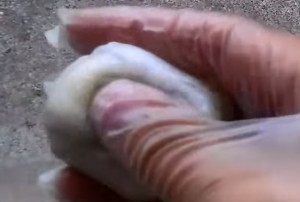Affordable Accuracy: Savage 10 BA Stealth Rifle—Full Review

The
Savage 10 BA Stealth, shown here chambered in 6.5 Creedmoor and
sporting a 24-inch barrel, offers beginning precision rifle shooters a
great gun at a great price.
Savage
is well-known for producing rifles that outperform their price points.
In fact, they often can outshoot rifles that cost twice as much or more.
I recently had a chance to try out the
10 BA Stealth,
which is designed to be lightweight, simple, and above all accurate.
It’s available in either .308 Win or 6.5 Creedmoor. Starting with a
factory blueprinted action, Savage adds a precision barrel, in this case
a 24-inch 1:8 twist, fluted barrel with 5/8 x 24” threading at the
muzzle. This barreled action is factory designed for the best possible
accuracy unlike others that simply drop a run-of-the-mill setup in a
nice stock. It comes with a single-piece flat rail (no elevation) for
scope attachment, and an oversized bolt knob.

The rifle feeds from an included 10-round detachable magazine.
SPECS
- Chambering: 6.5 Creedmoor
- Barrel: 24 inches
- OA Length: 38.5 inch
- Weight:9.2 pounds
- Stock: FAB Defense
- Sights: Scope rail provided
- Action: Bolt-action
- Finish: Black anodized
- Capacity: 10
- MSRP: $1,207
Savage has worked in conjunction with
Drake Associates
and uses their monolithic aluminum design chassis. Machined from a
solid billet it utilizes AICS-patterned magazines and an AR pistol grip
and buffer tube/stock. It houses an adjustable Savage AccuTrigger.
Minimalist in design, the stock extends forward slightly and uses M-LOK
rails to accommodate accessories, and a single sling stud is provided
from the factory. A
Fab Defense
stock using a cheek riser goes over the six position tube, but it will
accept any AR tube allowing the use of precision stock systems if
needed. At 9.2 pounds, it is as light as precision rifles go and well
balanced. Retail is $1,207.00 for both the .308 (with a 20-inch barrel)
and 6.5 Creedmoor (with a 24-inch barrel) models.
To my mind, it
is a great starter rifle for the precision rifle enthusiast due to its
retail price point of $1,207 and its ability to easily accept AR-pattern
accessories. This one has a lot of potential to get a lot of new (as
well as experienced) shooters out into the field of long-range shooting.

The author equipped the rifle with a Burris scope and GEMTECH suppressor for testing.
Testing
During my testing, scope duties were handled by Burris Optics new
XTR II 3-15x50mm FFP
(First Focal Plane) scope using a 34mm tube and SCR lighted Mil Lined
reticle. Mounted in a set of Vortex Precision Matched Rings, it zeroed
with ease. Clarity on the glass is excellent and the reticle is
comparable to any simple Mil-lined reticle on the market. The vertical
line has 20 mils graduated in half mil increments below the horizontal
line. There are five mils above with the last two graduated in .10
mils. Extending on either side are 10 mils graduated in .2 of a mile for
the first five where another .10 mils section sits for ranging
calculation. The center section is lighted for three mils on either side
and six mils below the center line. Dialed up to 15 power, there were
11 mils available for holds with the entire horizontal line visible.
Knobs are tactile with audible clicks at .10 mils per click and 10 mils
per revolution. The XTR uses a zero stop that is easily adjusted. Loosen
the screws, slip the knobs to zero and press firmly and re-tighten.
Parallax adjustment sits on the right along with lighted reticle
activation. There are 11 settings with “battery saver” steps in between
each setting and a hard “off” setting at both ends. Scope covers that
flip flat against the scope when open are included.

The Burris used during testing was an XTR II 3-15x50mm first focal plane model that really impressed the author.
If
at all possible, any precision rifle used for tactical work should be
suppressed. The advantages are huge, and the drawbacks short of cost are
all but non-existent. In keeping with that philosophy, I attached
Gemtech’s Dagger direct threat suppressor for all the testing. Rated to
.300 WM and built from titanium, it only weighs in at 15.3 ounces. It
can be used on smaller calibers on barrels as short as 7.5 inches for
300 BLK, and 10.3 inches in 5.56mm and 6.8 SPC. It’s even rated for a
12-inch .308 barrel and an 18-inch 300 WM, making it extremely
versatile.

The GEMTECH Dagger used by the author fit easily on the rifle’s threaded muzzle, and is rated up to .300 WM.
Range Time
Savage
starts with a blueprinted action to insure accuracy, and it worked.
Starting just after dawn it was cool and smoky due to some fires in the
area, but wind was minimal and the bugs had yet to come out. My first
group in testing measured just over half an inch, and it just got better
from there. My best group was fired using Hornady’s 143 Grain ELD-X
Precision Hunger at a tad over .35 inches. While I have produced better
groups in my life, I have not with a factory rifle costing just
$1,200.00. My next best group was produced using Doubletap’s rather
juicy 127-grain LRX at .45 inches. Nothing exceeded .70 inches during
the test, all were very consistent. Moving out to 500 yards on steel,
six rounds of Hornady/ELD match were loaded up with elevation dialed in
using data from my Kestrel Applied Ballistics Meter. Not a single miss
was had, with all hitting close to center.

The author’s best group of .35 inches was achieved with Hornady ammo, and all ammo tested came in sub-MOA.
Being
my first real test of the Burris XTR II, I was very impressed. Retail
pricing on this model is only $1,259.00, a price range that is becoming
incredibly competitive. Scopes that cost 3K are great and offer
features a few shooters need, but this Burris and similar scopes perform
well for the vast majority of conditions. The glass is as clear as any
in this price range; as clear as some with twice the price tag.
Measurements
were consistent when working from 100-800 yards using input from the
Kestrel. First round hits were the norm until the wind kicked up, but
elevation stayed consistent. Knobs are easy to grab with firm and
audible clicks. Setting the zero stop is easy and was used in between
each change of distance. When the day was done it held its zero to
within .25 inches. Given a 20-degree temperature change and a couple
hundred rounds using a suppressor, that is about as good as it gets.
Still more long-term testing to do, but if this run is any indication
this is an excellent scope in general, let alone for its price.
Gemtech
prides itself on sound reduction and their Dagger delivers. Most of the
time there was just a puff of white smoke. Most suppressors designed
primarily for sound reduction will result in increased bolt lift on
rapid fire strings, and this was no exception. It takes time to allow
the trapped gas to dissipate so run the bolt hard and fast, and by round
four or five you will need to work a bit harder to lift the bolt. Most
of the time a count of one or two seconds between shots eliminates
this. As a practical matter it’s not a concern for most precision
shooters, but if you compete with a suppressor you need to be aware of
it.

The FAB Defense stock came standard on the rifle, although the AR buffer tube extension design allows you to swap it.

The hand guard portion of the stock features M-LOK attachment points and is short and compact.

Hand
guards of reduced or minimal length like this one seem to be gaining in
popularity. Most shooters have no need to hang lasers, lights,
rangefinders, or anything other than a bi-pod off their rifles. If you
need all of those things, and or clip on NV (Night Vision), this stock
may be problematic. There is plenty of room for a light, maybe one
other device, but it will cramp your style a bit. If not, it saves quite
a bit of weight you will never use. Working barricades and around the
bench there was a tad less space for bags and the like, but not
unworkable at all. If you spend much of your time in prone or resting on
a bag it is fine.
The FAB Defense cheek rest on the stock never
came loose and provided a pretty solid purchase. It never collapsed
under recoil nor interfered with positions. Recoil was minimal with the
6.5 Creedmoor, so that was not an issue. If you want something different
it’s pretty easy, just swap them out. If you prefer a precision rifle
stock of some type you just change the buffer tube.
Bottom Line
If
you are looking for a reasonably priced precision rifle capable of
accuracy exceeding most shooters, the Savage 10 BA Stealth is an
excellent choice. You get a rifle with a blueprinted action, a great
barrel and impressive performance at a retail price of around $1,200.
Chambering it in 6.5 Creedmoor provides a solid platform for
longer-range target shooting and precision rifle competitions. The stock
is rock solid, it works with AICS magazines, it balances well, and
accuracy is excellent. It allows you to change stocks and pistol grips
as needed to meet personal needs. If it has a limitation, it’s the hand
guard length, but that’s all about personal need and preference. Far too
many people buy what they think is “operational” with features (and
weight) they just don’t need. If you are planning on hanging another 10
pounds of stuff on the end of your rifle you may want to look at
something different.

The AR-pattern grip performed well, and can be easily swapped out with any other AR-pattern grip.

The tang-mounted safety was simple and easy to operate for the author.
Savage
rifles have always been accurate, but they are also amongst the most
user friendly on the market. Barrel changes can be made with simple
tools due to the barrel nut system; no need to take them to a custom
shop. This rifle would accept any barrel change using a .308-based
cartridge pretty simply, so it’s easy to change caliber or even length
for different purposes.

The rifle comes standard with the terrific AccuTrigger system.
Savage
has done a great job with this rifle meeting what may be the largest
demographic for precision rifle shooters, the entry level. It will shoot
at a much higher level for sure, but it allows new shooters to
experience the joy that comes from ringing steel at 1,000 yards
consistently, or putting five rounds into a hole you can cover with a
dime. If you are new to precision rifle shooting and want a start, the
combination of the Stealth and the Burris HTR II worked great. For those
Savage fans, you now have an out-of-the-box blue printed action in a
proven long range caliber (6.5 Creedmoor) that is soft shooting and easy
to maneuver. Either way it is a great choice and should be added to
anyone’s list of precision rifle choices.
For more information, visit
http://www.savagearms.com/firearms/model/BAStealth.

 According
to a press release on the Para, the rifle features a machine gun-grade,
16.1-inch, cold hammer-forged barrel, closed bolt for semi-automatic
only operation, classic M249 flip-up feed tray, integrated steel bipod,
robust gas-piston system, and the iconic telescoping and rotating
buttstock, making it lighter and more compact. Rifles will be available
in either black or Flat Dark Earth (FDE).
According
to a press release on the Para, the rifle features a machine gun-grade,
16.1-inch, cold hammer-forged barrel, closed bolt for semi-automatic
only operation, classic M249 flip-up feed tray, integrated steel bipod,
robust gas-piston system, and the iconic telescoping and rotating
buttstock, making it lighter and more compact. Rifles will be available
in either black or Flat Dark Earth (FDE).


 The
bottom portion of a plastic bottle will work well as a base for
creating survival fire putty. However, it is important to note that this
is not a good long-term storage solution for the putty or the
ingredients that are used to make it. Simply cut the bottom portion off
of your bottle and you’ll be ready to move on to the next step.
The
bottom portion of a plastic bottle will work well as a base for
creating survival fire putty. However, it is important to note that this
is not a good long-term storage solution for the putty or the
ingredients that are used to make it. Simply cut the bottom portion off
of your bottle and you’ll be ready to move on to the next step.
 If
they’re not on yet, it is now time to don your plastic gloves. Make
sure you are using gloves that will not dissolve from acetone or
gasoline.
If
they’re not on yet, it is now time to don your plastic gloves. Make
sure you are using gloves that will not dissolve from acetone or
gasoline.










